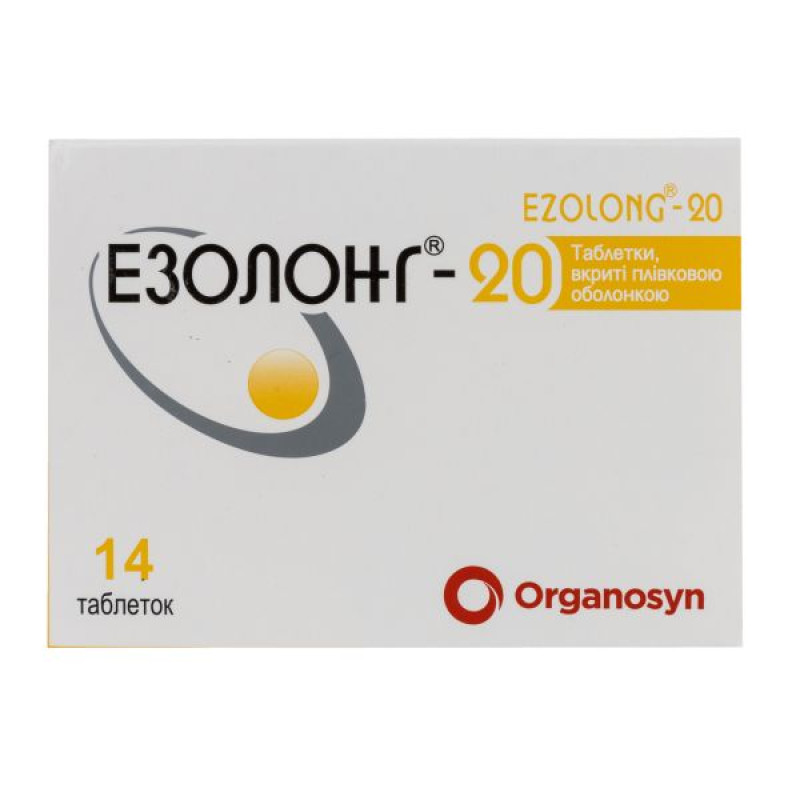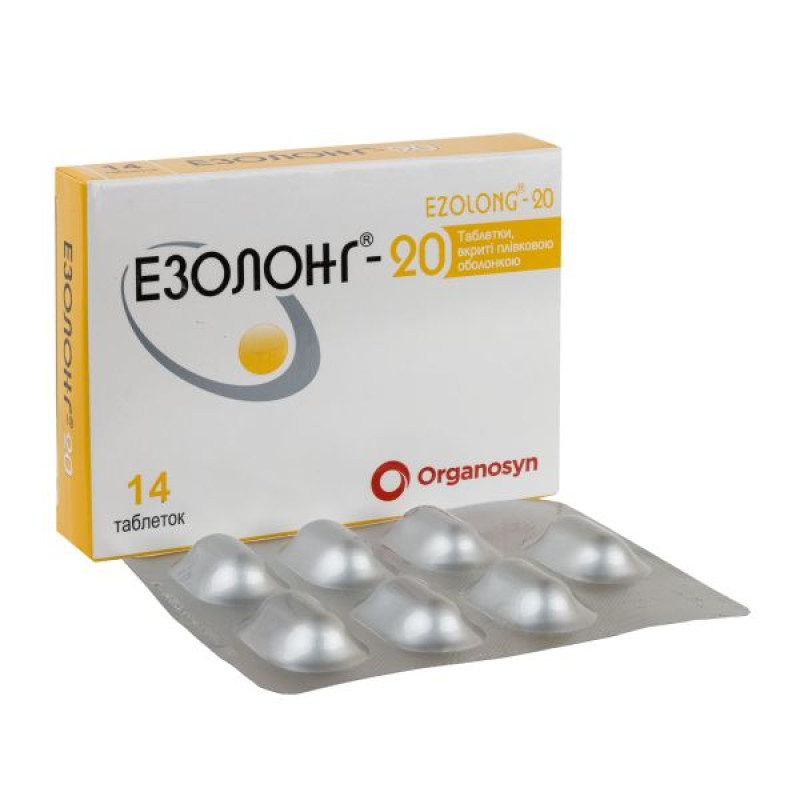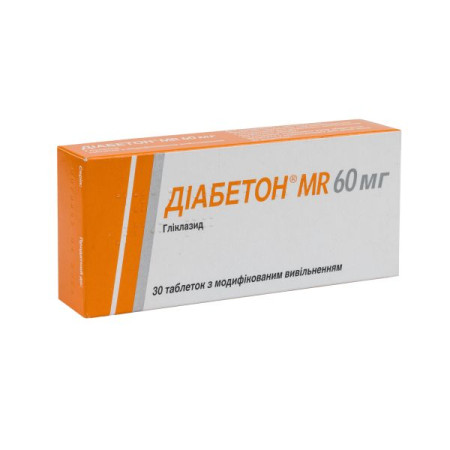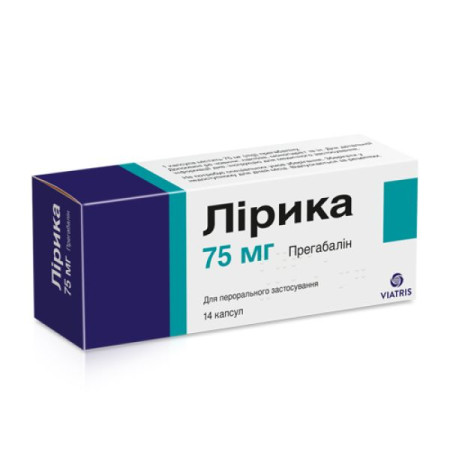Ezolong-20 film-coated tablets 20 mg blister No. 14
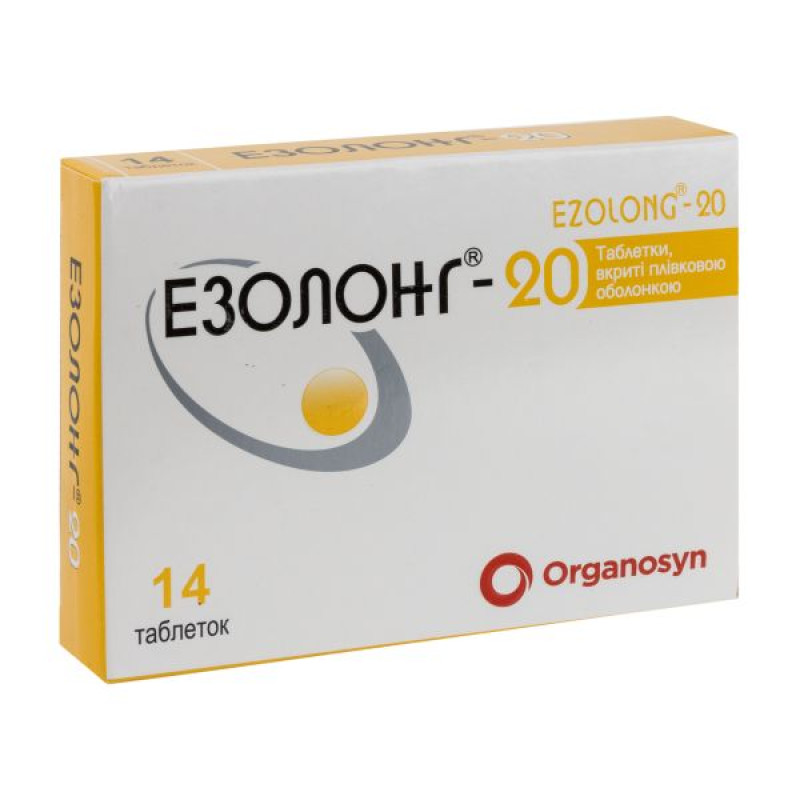
Instructions for Ezolong-20 film-coated tablets 20 mg blister No. 14
Composition
active ingredient: esomeprazole;
1 film-coated tablet contains esomeprazole magnesium trihydrate equivalent to esomeprazole 20 mg or 40 mg;
excipients: microcrystalline cellulose, sodium bicarbonate, colloidal anhydrous silicon dioxide, crospovidone, magnesium stearate, talc;
shell (Opadry White 58901, povidone (K-30), talc, iron oxide yellow (E 172) - available in film-coated tablets, 20 mg each, iron oxide red (E 172) - available in film-coated tablets, 40 mg each, mint flavoring).
Dosage form
Film-coated tablets.
Main physicochemical properties: oval, biconvex tablets, film-coated in pink (for 40 mg) or light yellow (for 20 mg), with a score line on one side.
Pharmacotherapeutic group
Drugs for the treatment of peptic ulcer and gastroesophageal reflux disease. Proton pump inhibitors. Esomeprazole. ATC code A02B C05.
Pharmacological properties
Pharmacodynamics
Esomeprazole is the S-isomer of omeprazole, which reduces gastric acid secretion by a specifically targeted mechanism of action. It is a specific inhibitor of the proton pump in the parietal cell. The R- and S-isomers of omeprazole have the same pharmacodynamic activity.
Esomeprazole is a weak base, it concentrates and converts to the active form in the highly acidic environment of the secretory tubules of the parietal cell, where it inhibits the enzyme H+K+-ATPase - the acid pump, and also suppresses basal and stimulated acid secretion.
After oral administration of 20 mg and 40 mg esomeprazole, the onset of action is within one hour. After repeated administration of 20 mg esomeprazole once daily for 5 days, the mean peak acid output after pentagastrin stimulation is reduced by 90% when measured 6-7 hours after the dose on day 5.
After 5 days of oral administration of esomeprazole 20 mg and 40 mg, gastric pH was >4 for a mean of 13 and 17 hours, respectively, and >24 hours in patients with symptomatic reflux esophagitis. The proportion of patients with gastric pH >4 for 8, 12, and 16 hours after 20 mg esomeprazole was 76%, 54%, and 24%, respectively. The corresponding proportions for 40 mg esomeprazole were 97%, 92%, and 56%.
When using AUC as an indirect indicator of plasma concentration, the dependence of acid secretion inhibition on drug exposure was shown.
Therapeutic effects of inhibiting hydrochloric acid secretion.
Treatment of reflux esophagitis with esomeprazole 40 mg was successful in approximately 70% of patients after 4 weeks of treatment and in 93% after 8 weeks of treatment.
Esomeprazole 20 mg twice daily for one week, together with appropriate antibiotics, resulted in successful eradication of Helicobacter pylori in approximately 90% of patients. After one week of treatment, no further antisecretory monotherapy was required for successful ulcer healing and symptom relief in uncomplicated duodenal ulcers.
Other effects associated with inhibition of hydrochloric acid secretion.
During the period of use of antisecretory drugs, plasma gastrin concentration increases in response to decreased acid secretion. Chromogranin A (CgA) also increases due to decreased gastric acidity.
It is possible that the increase in the number of ECL cells is associated with an increase in plasma gastrin levels, which has been observed in some patients with long-term use of esomeprazole.
There have been several reports of an increased incidence of gastric granular cysts with long-term use of antisecretory drugs. These phenomena are a physiological consequence of prolonged inhibition of acid secretion and are benign and reversible.
The reduction in gastric acidity caused by any proton pump inhibitor increases the number of bacteria normally present in the gastrointestinal tract in the stomach. Treatment with proton pump inhibitors may increase the risk of gastrointestinal infections caused by, for example, Salmonella or Campylobacter and, in hospitalised patients, possibly also Clostridium difficile.
Esomeprazole was more effective than ranitidine in treating stomach ulcers in patients treated with NSAIDs (nonsteroidal anti-inflammatory drugs), including selective COX-2 inhibitors.
Esomeprazole was effective in preventing gastric and duodenal ulcers in patients treated with nonsteroidal anti-inflammatory drugs (NSAIDs) (in patients aged 60 years and over and/or with a history of ulcer).
Pharmacokinetics
Absorption.
Esomeprazole is rapidly absorbed, with peak plasma concentrations occurring approximately 1-2 hours after dosing. Absolute bioavailability is 64% after a single 40 mg dose and increases to 89% after repeated once-daily dosing. For 20 mg esomeprazole, the corresponding values are 50% and 68%.
Food intake slows down and reduces the absorption of esomeprazole, but does not affect the effect of esomeprazole on gastric acidity.
The volume of distribution in healthy volunteers at steady state is 0.22 l/kg body weight. Esomeprazole is 97% bound to plasma proteins.
Metabolism.
Esomeprazole is completely metabolized by the cytochrome P450 (CYP) system. The main part of the metabolism of esomeprazole depends on the polymorphic CYP2C19, which is responsible for the formation of the hydroxy- and desmethyl metabolites of esomeprazole. The rest depends on a second specific isoform, CYP3A4, which is responsible for the formation of esomeprazole sulfone, the main metabolite in blood plasma.
Breeding.
The parameters listed below mainly reflect pharmacokinetics in individuals with a functional CYP2C19 enzyme (extensive metabolizers).
Total plasma clearance is approximately 17 l/h after a single dose and approximately 9 l/h after repeated dosing. The plasma elimination half-life is approximately 1.3 h after repeated once-daily dosing. Esomeprazole is completely eliminated from plasma between doses without any tendency for accumulation with once-daily dosing.
The main metabolites of esomeprazole do not affect gastric secretion. About 80% of an oral dose of esomeprazole is excreted in the form of metabolites in the urine, the rest in the intestines. Less than 1% of the parent drug is found in the urine.
Special patient groups.
Slow metabolizers.
Approximately 2.9 ± 1.5% of the patient population is deficient in the CYP2C19 enzyme (referred to as poor metabolisers). In these individuals, esomeprazole is predominantly metabolised by CYP3A4. After repeated once-daily administration of 40 mg esomeprazole, the mean area under the plasma concentration-time curve in poor metabolisers is approximately 100% higher than in subjects with normal CYP2C19 function (extensive metabolisers). The mean peak plasma concentration is increased by approximately 60%. These findings have no impact on the dosage of esomeprazole.
Patients with impaired liver function.
The metabolism of esomeprazole in patients with mild to moderate hepatic dysfunction may be impaired. The rate of metabolism is reduced in patients with severe hepatic impairment, resulting in a 2-fold increase in the area under the plasma concentration-time curve. Therefore, the maximum dose for patients with severe hepatic impairment is 20 mg. Esomeprazole and its metabolites do not tend to accumulate when administered once daily.
Patients with impaired renal function.
No studies have been conducted in this patient population. Since the kidneys are responsible for the excretion of esomeprazole metabolites and not the parent compound, no changes in metabolism are expected in patients with renal impairment.
Elderly patients.
The metabolism of esomeprazole does not undergo significant changes in elderly patients (71 to 80 years).
Pediatric patients.
After multiple doses of 20 mg and 40 mg esomeprazole, the overall exposure and time to peak plasma concentrations in children aged 12-18 years were similar to those in adults.
Gender characteristics.
After a single dose of 40 mg esomeprazole, the mean area under the plasma concentration-time curve was 30% higher in women than in men. No gender-related differences were observed with repeated once-daily dosing. These findings do not impact the dosing of esomeprazole.
Indication
Adults
Gastroesophageal reflux disease (GERD):
- treatment of erosive reflux esophagitis;
- long-term treatment with cured esophagitis to prevent relapse;
- symptomatic treatment of gastroesophageal reflux disease.
In combination with appropriate antibacterial therapeutic agents for the eradication of Helicobacter pylori:
- treatment of duodenal ulcers associated with Helicobacter pylori;
- prevention of recurrence of peptic ulcers in patients with ulcers caused by Helicobacter pylori.
Treatment and prevention of ulcers caused by long-term use of nonsteroidal anti-inflammatory drugs (NSAIDs):
- treatment of ulcers caused by NSAID therapy;
- prevention of gastric and duodenal ulcers caused by the use of NSAIDs in patients at risk.
Long-term treatment after intravenous administration of the drug for the prevention of recurrent bleeding from peptic ulcers.
Treatment of Zollinger-Ellison syndrome.
Children aged 12 and over
Gastroesophageal reflux disease (GERD):
- treatment of erosive reflux esophagitis;
- long-term treatment of patients with cured esophagitis to prevent relapse;
- symptomatic treatment of gastroesophageal reflux disease (GERD).
In combination with antibiotics in the treatment of duodenal ulcers caused by Helicobacter pylori.
Contraindication
Known hypersensitivity to esomeprazole, substituted benzimidazoles or to any of the other ingredients of the drug. Esomeprazole should not be used concomitantly with atazanavir, nelfinavir (see section "Interaction with other medicinal products and other forms of interaction").
Interaction with other medicinal products and other types of interactions
Effect of esomeprazole on the pharmacokinetics of other drugs.
Omeprazole has been reported to interact with some protease inhibitors (antiretroviral drugs). The clinical significance and mechanisms of such interactions are not always known. The increase in gastric pH during omeprazole use may alter the absorption of protease inhibitors. Other mechanisms of interaction may be related to inhibition of CYP2C19. In the case of some antiretroviral drugs, such as atazanavir and nelfinavir, decreased serum levels of the latter have been observed when administered concomitantly with omeprazole. Therefore, concomitant use of omeprazole and drugs such as atazanavir and nelfinavir is not recommended. The use of omeprazole (40 mg once daily) with atazanavir 300 mg and ritonavir 100 mg in healthy volunteers resulted in a significant decrease in the exposure of atazanavir (approximately 75% decrease in AUC, Cmax, Cmin). Increasing the dose of atazanavir to 400 mg did not compensate for the effect of omeprazole on the efficacy of atazanavir.
Co-administration of omeprazole 20 mg daily with atazanavir 400 mg/ritonavir 100 mg in healthy volunteers decreased atazanavir exposure by approximately 30% compared to the exposure determined with atazanavir 300 mg/ritonavir 100 mg once daily without omeprazole 20 mg daily.
During concomitant therapy with omeprazole (40 mg daily), serum levels of saquinavir (co-administered with ritonavir) were reported to increase. Treatment with omeprazole 20 mg daily had no effect on the exposure of darunavir (co-administered with ritonavir) and amprenavir (co-administered with ritonavir). Treatment with esomeprazole 20 mg daily had no effect on the exposure of amprenavir (co-administered with or without ritonavir). Treatment with omeprazole 40 mg daily had no effect on the exposure of lopinavir (co-administered with ritonavir).
Due to the similarity of pharmacodynamic effects and pharmacokinetic properties of omeprazole and esomeprazole, the concomitant use of esomeprazole with atazanavir is not recommended. The concomitant use of esomeprazole with nelfinavir is contraindicated.
Methotrexate.
Increased blood levels of methotrexate have been reported in some patients when co-administered with proton pump inhibitors. Temporary withdrawal of esomeprazole should be considered when high doses of methotrexate are prescribed.
Tacrolimus
Increased serum tacrolimus levels have been reported with concomitant use of esomeprazole. Increased monitoring of tacrolimus concentrations and renal function (creatinine clearance) is required; tacrolimus dosage should be adjusted if necessary.
Drugs whose absorption depends on pH
Suppression of gastric acidity during treatment with esomeprazole and other PPI drugs may reduce or increase the absorption of drugs whose absorption depends on the pH of gastric juice.
As with other drugs that reduce gastric acidity, the absorption of drugs such as ketoconazole, itraconazole and erlotinib may be reduced, while the absorption of drugs such as digoxin may be increased during treatment with esomeprazole. Concomitant administration of omeprazole (20 mg daily) and digoxin in healthy volunteers increased the bioavailability of digoxin by 10% (in two out of ten subjects - up to 30%). Rare cases of digoxin-induced toxicity have been reported. However, caution should be exercised when prescribing high doses of esomeprazole to elderly patients. Therapeutic drug monitoring of digoxin should be increased.
Drugs metabolized by CYP2C19
Esomeprazole is an inhibitor of CYP2C19, the main enzyme that metabolizes esomeprazole. Accordingly, when esomeprazole is combined with drugs that are metabolized by CYP2C19, such as diazepam, citalopram, imipramine, clomipramine, phenytoin, etc., the plasma concentrations of these drugs may increase and a dose reduction may be necessary. This should be taken into account in particular when esomeprazole is prescribed for "on-demand" use.
Diazepam.
Concomitant use of esomeprazole at a dose of 30 mg resulted in a 45% decrease in the clearance of diazepam, a CYP2C19 substrate.
Phenytoin.
With the concomitant use of esomeprazole at a dose of 40 mg in patients with epilepsy, an increase in the minimum plasma concentration of phenytoin by 13% was noted. It is recommended to monitor the level of phenytoin in the blood plasma at the beginning of therapy with esomeprazole or in case of its cancellation.
Voriconazole.
Omeprazole (40 mg once daily) increased the Cmax and AUCτ of voriconazole (a CYP2C19 substrate) by 15% and 41%, respectively.
Cilostazol.
Omeprazole and esomeprazole act as inhibitors of CYP2C19. In a cross-over study, omeprazole 40 mg in healthy volunteers increased the Cmax and AUC of cilostazol by 18% and 26%, respectively, and one of its active metabolites by 29% and 69%, respectively.
In healthy volunteers, when co-administered with esomeprazole (40 mg), the area under the plasma concentration-time curve (AUC) of cisapride increased by 32% and the elimination half-life (t½) increased by 31%, but no significant increase in maximum plasma levels of cisapride was observed. The slight prolongation of the QTc interval observed with cisapride alone was not observed when cisapride was co-administered with esomeprazole (see also section 4.4).
Warfarin.
In clinical trials, it was shown that concomitant use of esomeprazole at a dose of 40 mg in patients on warfarin therapy maintained coagulation times within acceptable limits. However, in the post-marketing period, a few isolated cases of clinically significant increases in the international normalized ratio (INR) have been reported during concomitant use of these drugs. Monitoring is recommended at the beginning and after the end of concomitant use of esomeprazole with warfarin or other coumarin derivatives.
Clopidogrel.
In healthy subjects, a pharmacokinetic/pharmacodynamic interaction was observed between clopidogrel (300 mg loading dose/75 mg daily maintenance dose) and esomeprazole (40 mg daily orally), resulting in a mean 40% decrease in exposure to the active metabolite of clopidogrel and a mean 14% decrease in maximal inhibitory activity (ADP-induced) against platelet aggregation.
In a study in healthy volunteers, when clopidogrel was administered with esomeprazole and acetylsalicylic acid (ASA) in a fixed dose combination (20 mg + 81 mg respectively) compared to clopidogrel alone, there was a reduction in exposure to the active metabolite of clopidogrel by almost 40%. However, the maximum levels of inhibition of (ADP-induced) platelet aggregation in these subjects were the same in the clopidogrel monotherapy group and in the clopidogrel plus esomeprazole and ASA group. Several observational and clinical studies have shown conflicting data on the clinical aspects of the PK/PD interaction of esomeprazole with respect to major cardiovascular events. As a precautionary measure, concomitant use of esomeprazole and clopidogrel should be avoided.
Investigational medicinal products without clinically significant interactions
Amoxicillin or quinidine
It was noted that esomeprazole had no clinically significant effect on the pharmacokinetics of amoxicillin or quinidine.
Naproxen or rofecoxib
No pharmacokinetic interactions were observed during short-term studies of concomitant use of esomeprazole with naproxen or rofecoxib.
Effect of other medicinal products on the pharmacokinetics of esomeprazole
Drugs that inhibit CYP2C19 and/or CYP3A4 activity
Esomeprazole is metabolised by CYP2C19 and CYP3A4. Co-administration of esomeprazole and the CYP3A4 inhibitor clarithromycin (500 mg twice daily) resulted in a doubling of esomeprazole exposure (AUC). Co-administration of esomeprazole and a combined CYP2C19 and CYP3A4 inhibitor may result in a more than two-fold increase in esomeprazole exposure. The CYP2C19 and CYP3A4 inhibitor voriconazole increased the AUCτ of omeprazole by 280%. Dose adjustment of esomeprazole is not always necessary in these situations. However, it may be necessary in patients with severe hepatic impairment and in cases where long-term treatment is indicated.
Drugs that induce CYP2C19 and/or CYP3A4 activity
Drugs known to induce the activity of CYP2C19 or CYP3A4 or both enzymes (such as rifampicin and St. John's wort) may lead to decreased serum levels of esomeprazole by increasing its rate of metabolism.
Pediatric population
Drug interaction studies have only been conducted in adults.
Application features
In the presence of any alarming symptoms (such as significant unexpected weight loss, recurrent vomiting, dysphagia, haematemesis or melena) and in the presence or suspicion of gastric ulcer, malignant disease should be excluded, as Ezolong may mask symptoms and delay diagnosis.
Long-term use of the drug
Patients taking the drug for a long period (especially patients receiving treatment with the drug for more than a year) should be under regular medical supervision.
Treatment on demand
Patients taking Ezolong as needed should be instructed to contact their physician if symptoms change.
Helicobacter pylori eradication
When prescribing esomeprazole for the eradication of Helicobacter pylori, the possibility of drug interactions between all components of the triple therapy should be taken into account. Clarithromycin is a potent inhibitor of CYP3A4, therefore, when prescribing triple therapy to patients receiving other drugs metabolized by CYP3A4 (e.g. cisapride), it is necessary to consider possible contraindications and interactions of clarithromycin with these drugs.
Gastrointestinal infections
The use of proton pump inhibitors may slightly increase the risk of developing gastrointestinal infections such as Salmonella and Campylobacter (see section "Pharmacodynamics").
Esomeprazole, like all drugs that block the action of hydrochloric acid, may reduce the absorption of vitamin B12 (cyanocobalamin) due to the development of hypo- or achlorhydria. This should be taken into account in the case of long-term treatment of patients with reduced vitamin B12 stores in the body or patients with risk factors for reduced vitamin B12 absorption.
Hypomagnesemia
Severe hypomagnesemia has been reported in patients treated with proton pump inhibitors (PPIs) such as esomeprazole for at least three months, and in most cases for a year. Serious manifestations of hypomagnesemia such as fatigue, tetany, delirium, seizures, dizziness, and ventricular arrhythmias may occur, but these symptoms may be insidious in onset and may be missed. In most cases, patients with hypomagnesemia improved after magnesium replacement therapy and discontinuation of PPI therapy.
For patients expected to be on long-term treatment, or for patients receiving PPI treatment concomitantly with digoxin or medicinal products that may cause hypomagnesaemia (e.g. diuretics), healthcare professionals should consider determining magnesium levels before initiating PPI treatment and periodically during therapy.
Risk of fractures
Proton pump inhibitors, especially at high doses and during long-term treatment (> 1 year), may slightly increase the risk of hip, wrist and spine fractures, mainly in elderly patients or in the presence of other risk factors. Observational data suggest that proton pump inhibitors may increase the overall risk of fractures by 10-40%. Some of these increased fractures may be associated with other risk factors. Patients at risk of osteoporosis should be treated according to current clinical guidelines and receive adequate vitamin D and calcium.
Subacute cutaneous lupus erythematosus
The use of proton pump inhibitors has been associated with very rare cases of subacute cutaneous lupus erythematosus. If lesions occur, especially in areas exposed to sunlight, and this is accompanied by arthralgia, the patient should immediately consult a doctor who will consider the need to discontinue the use of Ezolong. The occurrence of subacute cutaneous lupus erythematosus in patients during previous therapy with proton pump inhibitors may increase the risk of its development with the use of other proton pump inhibitors.
Serious cutaneous adverse reactions (SCARs), such as erythema multiforme (EM), Stevens-Johnson syndrome (SJS), toxic epidermal necrolysis (TEN) and drug reaction with eosinophilia and systemic symptoms (DRESS), which can be life-threatening, have been reported very rarely in association with esomeprazole treatment.
Patients should be informed of the signs and symptoms of severe skin reaction (ME/SSD/TEN/DRESS) and to seek immediate medical attention from their physician if any signs or symptoms occur.
Esomeprazole should be discontinued immediately if signs and symptoms of serious skin reactions appear and additional medical attention/careful monitoring should be provided as necessary.
Patients with ME/SSD/TEN/DRESS should avoid reinfection.
Effects on the kidneys
Acute tubulointerstitial nephritis (TIN) has been observed in patients taking esomeprazole and naproxen-containing products and may occur at any time during therapy with Ezolong.
Acute tubulointerstitial nephritis may progress to renal failure. Ezolong should be discontinued if TIN is suspected and appropriate treatment should be initiated immediately.
Combination with other drugs
The concomitant use of esomeprazole with atazanavir is not recommended (see section 4.5). If the combination of atazanavir with a proton pump inhibitor cannot be avoided, close monitoring of patients in a hospital setting is recommended, and the dose of atazanavir should be increased to 400 mg with 100 mg ritonavir; the dose of esomeprazole should not exceed 20 mg.
Esomeprazole is an inhibitor of CYP2C19. When initiating or ending treatment with esomeprazole, the potential for interactions with drugs metabolised by CYP2C19 should be considered. Interactions have been observed between clopidogrel and esomeprazole (see section 4.5).
The clinical significance of this interaction remains uncertain. As a precautionary measure, concomitant use of esomeprazole and clopidogrel should be avoided.
When prescribing esomeprazole for use on an "as needed" basis, due to fluctuations in esomeprazole plasma concentrations, the consequences of drug interactions with other medicinal products should be taken into account, see section "Interaction with other medicinal products and other types of interactions".
Impact on laboratory test results
Use during pregnancy or breastfeeding
Pregnancy period.
There are currently no adequate data on the use of esomeprazole during pregnancy. A somewhat larger number of epidemiological studies of the use of the racemic mixture of omeprazole during pregnancy indicate the absence of congenital malformations and fetotoxic effects. Animal studies of esomeprazole have not shown direct or indirect harmful effects on embryonal/fetal development. Animal studies of the racemic mixture have not shown direct or indirect harmful effects on pregnancy, parturition or postnatal development. The drug should be administered with caution to pregnant women.
A moderate amount of data on pregnant women (300 to 1000 pregnancy outcomes) indicate no malformative or foeto/neonatal toxicity of esomeprazole.
The results of animal studies indicate the absence of direct or indirect harmful effects of the drug on reproductive function due to its toxic effect.
Breastfeeding period.
It is not known whether esomeprazole is excreted in human milk. There is insufficient information on the effects of esomeprazole on newborns/infants. Esomeprazole should not be used during breast-feeding.
Fertility.
Animal studies of the racemic mixture of omeprazole indicate no effect of omeprazole on fertility when administered orally.
Ability to influence reaction speed when driving vehicles or other mechanisms
Esomeprazole has minimal influence on the ability to drive and use machines. Adverse reactions such as dizziness (uncommon) and blurred vision (rare) have been reported (see section 4.8). If these disorders occur, patients should not drive or use machines.
Method of administration and doses
Adults
Gastroesophageal reflux disease (GERD)
- Treatment of erosive reflux esophagitis
40 mg once daily for 4 weeks.
Patients with untreated esophagitis or persistent symptoms are recommended to use the drug for an additional 4 weeks.
- Long-term treatment of patients with cured esophagitis to prevent relapse
20 mg once daily.
- Symptomatic treatment of gastroesophageal reflux disease (GERD)
The dose for patients without esophagitis is 20 mg once daily. If after 4 weeks of treatment the symptoms are not controlled, the patient should be reassessed. After symptoms have resolved, 20 mg once daily may be sufficient for continued control. If necessary, the drug can be switched to an “as needed” regimen, i.e. 20 mg once daily. The use of the drug “as needed” for continued control of symptoms is not recommended in patients at risk of developing gastric and duodenal ulcers who are taking NSAIDs.
In combination with appropriate antibacterial therapeutic agents for the eradication of Helicobacter pylori, as well as for
- treatment of duodenal ulcers caused by Helicobacter pylori, and
- prevention of recurrence of peptic ulcers in patients with ulcers caused by Helicobacter pylori:
20 mg of Ezolong with 1 g of amoxicillin and 500 mg of clarithromycin twice daily for 7 days.
Patients requiring long-term use of nonsteroidal anti-inflammatory drugs (NSAIDs)
- Treatment of gastric ulcers caused by the use of NSAIDs
The usual dose is 20 mg once a day. The duration of treatment is 4-8 weeks.
- Prevention of gastric and duodenal ulcers caused by the use of NSAIDs in patients at risk
20 mg once daily.
Long-term treatment after intravenous administration of the drug for the prevention of recurrent bleeding from peptic ulcers
40 mg once daily for 4 weeks following intravenous administration of the drug for the prevention of recurrent bleeding from peptic ulcers.
Treatment of Zollinger-Ellison syndrome
The recommended starting dose of Ezolong is 40 mg twice a day. The dose is then adjusted individually; treatment is continued for as long as clinically indicated. Based on available clinical data, control of the condition can be achieved in most patients with doses of 80 to 160 mg of esomeprazole per day. If doses exceed 80 mg per day, the dose should be divided and administered twice a day.
Patients of special groups
Patients with impaired renal function
No dose adjustment is required in patients with impaired renal function. Due to limited experience in patients with severe renal impairment, caution should be exercised when treating such patients (see section 5.2).
Patients with impaired hepatic function
No dose adjustment is required in patients with mild to moderate hepatic impairment. The maximum dose of Ezolong for patients with severe hepatic impairment should not exceed 20 mg (see Pharmacokinetics).
Elderly patients do not need dose adjustment.
Pediatric population
Children aged 12 and over.
Gastroesophageal reflux disease (GERD)
- Treatment of erosive reflux esophagitis
40 mg once daily for 4 weeks.
Patients with untreated esophagitis or persistent symptoms are recommended to use the drug for an additional 4 weeks.
- Long-term treatment of patients with cured esophagitis to prevent relapse
20 mg once daily.
- Symptomatic treatment of gastroesophageal reflux disease (GERD)
The dose for patients without esophagitis is 20 mg once daily. If after 4 weeks of treatment the symptoms are not controlled, the patient should be re-evaluated. Once symptoms have resolved, further control may be achieved by increasing the dose to 20 mg once daily.
Treatment of duodenal ulcers caused by Helicobacter pylori
When choosing the appropriate combination therapy, official national, regional and local guidelines on bacterial resistance, duration of treatment (usually 7 days, but sometimes up to 14 days) and appropriate use of antibacterial agents should be taken into account. Treatment should be carried out under specialist supervision.
Dosage recommendations:
with a body weight of 30-40 kg: in combination with two antibiotics: Ezolong 20 mg, amoxicillin 750 mg and clarithromycin 7.5 mg/kg of body weight – all drugs should be used simultaneously twice a day for one week;
with body weight > 40 kg: in combination with two antibiotics: Ezolong 20 mg, amoxicillin 1 g and clarithromycin 500 mg – all drugs should be used simultaneously twice a day for one week.
Children under 12 years old
Ezolong should not be used in children under 12 years of age, as there is no data on such use.
Method of application
The tablet should be swallowed whole with liquid. The tablets should not be chewed or crushed.
Children
Ezolong should not be used in children under 12 years of age, as there is no data on such use.
Use in children over 12 years of age for the following indications:
Gastroesophageal reflux disease (GERD)
- treatment of erosive reflux esophagitis;
- long-term treatment of patients with cured esophagitis to prevent relapse;
- symptomatic treatment of gastroesophageal reflux disease (GERD).
In combination with antibiotics in the treatment of duodenal ulcers caused by Helicobacter pylori.
Overdose
There is currently very limited information on intentional overdose. Symptoms reported with a dose of 280 mg included gastrointestinal symptoms and weakness. A single dose of 80 mg esomeprazole did not cause any adverse effects. There is no known specific antidote. Esomeprazole is highly bound to plasma proteins and dialysis is therefore unlikely to remove it. As with any overdose, symptomatic and general supportive treatment should be provided.
Adverse reactions
Summary of safety profile
Among the adverse reactions that most often occur during clinical trials (as well as during post-marketing use of esomeprazole), headache, abdominal pain, diarrhea and nausea are noted. In addition, the safety profile of esomeprazole is the same across different dosage forms, indications for use
There are no reviews for this product.
There are no reviews for this product, be the first to leave your review.
No questions about this product, be the first and ask your question.




